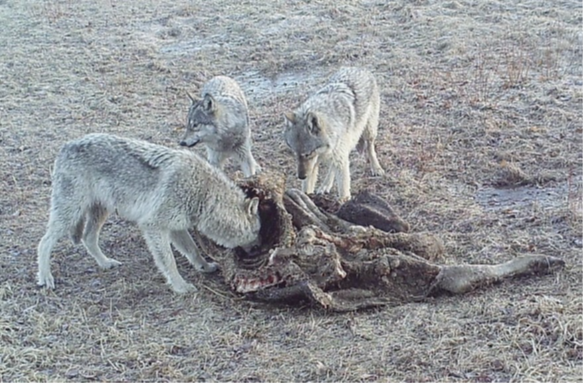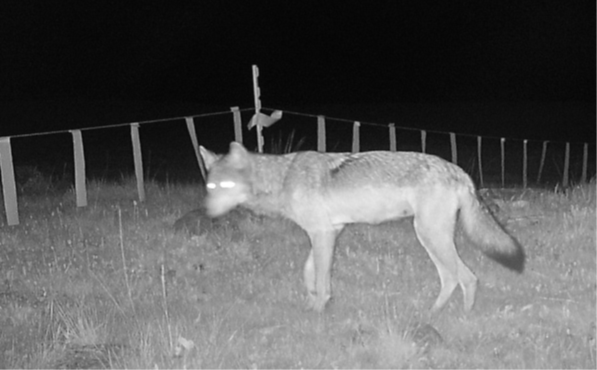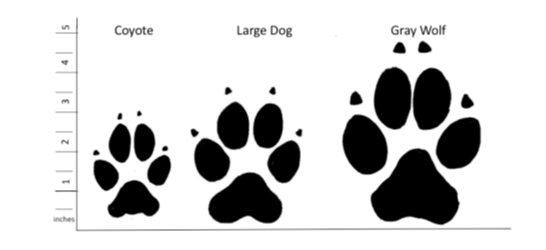Return to Wolf Depredation main menu
Wolf Predation
Wolves in Minnesota eat primarily wild prey – mostly deer, moose and beaver, but they occasionally kill or injure domestic animals including cattle, sheep, other hoof stock, poultry and dogs. Wolf damage to domestic animals can happen at any time of the year, but peaks during the summer when livestock are on summer grazing areas. Coyotes, black bears, foxes, bobcats, and domestic and feral dogs also occasionally kill livestock or poultry. While wolf predation does not impact livestock production at the state level, losses to individual producers and in localized areas may be significant.

WHAT YOU CAN DO TO PROTECT YOUR ANIMALS
As a livestock producer or domestic animal owner, you can take steps to prevent or minimize conflicts with wolves.
- Monitoring for wolf activity near your animals. This may include wolf tracks, scat, howling, sightings and trail camera photos. Be aware of changes to your herds behavior – skittish, nervous herds may indicate harassment or increased presence of wolves.
- Maintaining healthy, well-fed animals. Wolves typically select the weakest and easiest prey. Healthy animals are more difficult to take. Move lame or sick animals to a safe area when possible.
- Properly disposing of dead livestock carcasses. While there is no hard data to support that open livestock carcass disposal contributes to wolf depredations on domestic livestock, a large livestock carcass or carcasses can concentrate wolf activity on or near an individual operation. This can be at an especially critical time of year when many cattle producers have vulnerable livestock nearby. Proper carcass disposal, while required by MN law, can be very difficult, especially during the winter months. Rendering services are very rare in most of the MN wolf range which means each producer should have a plan in place to incinerate, bury or properly compost dead livestock.
- Using guard animals. Both donkeys and livestock guarding dogs have been successfully used to protect livestock in Minnesota. Although not always effective, the presence of livestock guarding animals can be a deterrent to wolves. Livestock guarding dogs are usually bred and trained specifically to protect livestock. An experienced breeder should be contacted before making the commitment to own livestock guarding dogs. Multiple livestock guarding dogs may be more effective at deterring wolves than a single dog.
- Newborns are easy prey. Move calving or lambing activities closer to the barnyard or areas that can be patrolled regularly. Avoid having young livestock in brushy or wooded pastures that can allow wolves to approach undetected and make livestock kills harder to find.
- Improved fencing. While truly wolf proof fencing is very expensive and cost prohibitive for most producers, even properly installed and maintained 6’ woven wire can deter wolves from entering your livestock areas.
WHAT TO DO IF YOU SUSPECT WOLVES HAVE KILLED ONE OF YOUR ANIMALS?

- Preserve any evidence of the carcass so that a USDA Wildlife Services employee, DNR conservation officer or other state authorized investigator can examine it to determine if its wolf predation. Photographs of the carcass from different angles as it was found may help the investigator make a clearer determination. Be cautious not to trample over animal tracks or disturb the site.
- Look for tracks or scat (droppings) that will show a wolf's presence. Preserve any tracks or scat if possible. Photos of the tracks or scat next to a common sized object such as a dol-lar bill for scale may help the investigator determine the species involved.
- Be aware that wolves will likely return to the carcass and may eat or carry off the remaining evidence so cover it with a tarp if possible or if a small calf, bring the entire carcass home. This also prevents scavenging birds and mammals from consuming the carcass.
- Call your local MN DNR Conservation Officer, USDA-Wildlife Services office in Grand Rapids as soon as possible. If in Kittson County, the Sheriff’s Office is also an additional authorized investigator. Timely reporting pro-vides the investigator better opportunity to accurately determine the cause of predation and allows Wildlife Services staff to respond quicker to protect the rest of your herd.
- Protect your remaining animals by temporarily moving them to a more secure location, if possible. Secure the area from the entry of livestock. Curious animals or upset mothers can destroy evidence quickly.
- Under Board of Animal Health regulations you must properly dispose of carcasses within 72 hours. Please work with the investigator on a carcass disposal plan.
AGENCY ASSISTANCE

Wolf Damage Management.
The U.S. Department of Agriculture – Wildlife Services program based in Grand Rapids offers operational and technical assistance to domestic animal owners with wolf issues. A full-time conflict prevention specialist is available to respond to various wolf issues, particularly those that haven’t involved a verified depredation. Wildlife Services has several non-lethal tools available to domestic animal owners that may deter wolves from entering pasture areas.
- Fladry is a temporary fence made with fabric flagging that offers a visual barrier to wolves that that helps to discourage them from entering protected areas. It can be electrified for increased effectiveness and is resistant to livestock impacts. When energized, it is often referred to as turbo fladry. Fladry is best used to protect relatively small areas generally 40 acres or less, but it can be adapted in some situations to protect larger areas. Fladry is a temporary novel barrier to wolves on the landscape. Its effects at deterring wolves generally declines after 90-120 days, sometimes sooner.
- There are other non-lethal devices that may provide temporary deterrents to wolves. These include light and sounds making devices, some motion activated. These devices are available commercially and may be available through Wildlife Services.
- Wildlife Services can also provide technical assistance with fence design and other mitigation measures on a case by case basis.
- In some cases, generally related to verifiable wolf predation, Wildlife Services or a MNDNR state certified gray wolf controller may legally remove wolves from a property immediately following a depredation.
- The Minnesota Department of Agriculture Wolf Livestock Conflict Prevention Grant Program offers a cost share program for producers to help them protect their animals.
COMPENSATION
After reporting the incident, an authorized investigator will investigate and may verify the wolf kill for compensation. You will be asked to complete an application for state compensation. The report will then be sent to MDA for valuation and payment by the investigator.
For operational wolf damage management assistance contact:
USDA Wildlife Services
34912 US Hwy 2
Grand Rapids, MN 55744
(218) 327-3350
For information on the MDA Wolf Livestock Conflict Prevention Grant and Compensation Programs, contact:
NiCole Rawski
Minnesota Department of Agriculture
625 Robert Street North
St Paul, MN 55155
nicole.rawski@state.mn.us
(651) 201-6095
To locate a Minnesota Conservation Officer:
https://www.dnr.state.mn.us/officerpatrolareas/index.html

